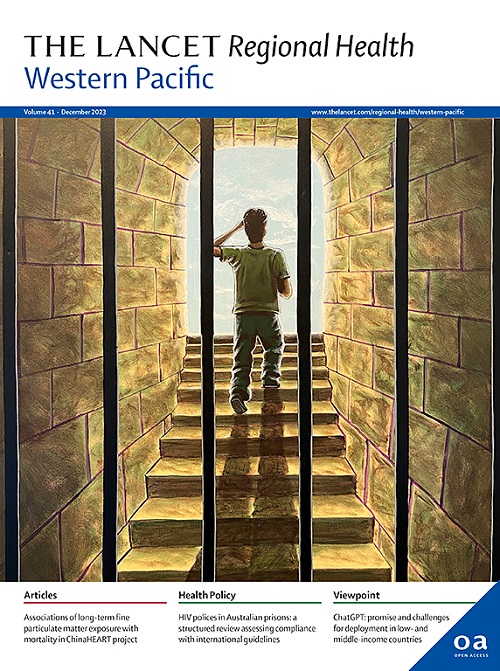中国前列腺特异性抗原筛查的成本-效果分析:基于中等收入人群的微观模拟研究
IF 8.1
1区 医学
Q1 HEALTH CARE SCIENCES & SERVICES
引用次数: 0
摘要
前列腺特异性抗原(PSA)在减轻前列腺癌健康负担中的意义被广泛讨论。我们进行了这项研究,利用现实世界的数据,开发一个全面的,成本效益分析模型的PSA筛查。通过评估各种筛查策略,我们的目标是为决策者提供强有力的研究证据,为未来的PSA筛查政策提供信息。方法:基于一项为期5年的104,751名参与者的试验数据、20年的多中心数据库和在中国收集的参数,以及基于家族史、多基因风险评分和高外显率基因的遗传风险分层方法,我们构建了一个微观模拟模型,以评估56种常规人群PSA筛查策略。临床结果包括发病率、转移发生率(M/I比率)和年病死率(CFR)。使用增量质量调整寿命年(QALYs)和增量成本-效果比(ICERs)评估成本-效果。进行敏感性分析和情景分析以检验结果的稳健性。所有策略都带来了质量aly的收益,并且在与中国人均GDP(每个质量aly 12,510.12美元)相等的支付意愿阈值下被认为具有成本效益。最密集的方案(45-74岁,每年,有年龄特异性PSA截止值)的ICER为5535.25美元/QALY,与未筛查相比,QALY增加2.79,M/I比率从39.05%降至1.04%,CFR从6.14%降至2.85%。遗传风险特异性方案提供了相当的QALY (2.79 vs 2.76)和ICERs (5287.23 vs 4904.90美元/QALY),允许66.8%的平均风险个体延长筛查间隔或推迟筛查开始年龄。psa筛查在中国具有以成本效益的方式改善整体健康结果的潜力。基于遗传风险的个性化筛查可能提供统一策略的有效替代方案,可能减少风险较低人群中不必要的干预。本研究为中国决策者考虑建立具有成本效益、风险分层的前列腺癌筛查方案提供了坚实的证据基础。资助深港澳科技计划、港大种子基金、RJH培育之星计划、香港大学教育资助委员会研究影响基金及广东省高层次人才计划。本文章由计算机程序翻译,如有差异,请以英文原文为准。
Cost–effectiveness analysis of prostate-specific antigen screening in China: a middle-income population-based microsimulation study
Background
The significance of prostate-specific antigen (PSA) in reducing the health burden of prostate cancer is widely deliberated. We conducted this study, utilising real-world data, to develop a comprehensive, cost-effectiveness analysis model for PSA screening. By evaluating various screening strategies, we aim to provide policymakers with robust research evidence to inform future PSA screening policies.
Methods
We constructed a microsimulation model to assess 56 conventional population-wide PSA screening strategies based on data from a five-year trial with 104,751 participants, a 20-year multicentre database and parameters collected across China, along with approaches involving genetic risk stratification based on family history, polygenic risk scores, and high-penetrance genes. Clinical outcomes including incidence, metastasis-incidence ratio (M/I ratio), and annual case-fatality rate (CFR) were evaluated. Cost-effectiveness was evaluated using incremental quality-adjusted life years (QALYs) and incremental cost-effectiveness ratios (ICERs). Sensitivity and scenario analyses were conducted to test the robustness of the results.
Findings
All strategies led to QALY gains and were considered cost-effective under a willingness-to-pay threshold equal to China's per capita GDP ($12,510.12 per QALY). The most intensive protocol (45–74 years, annually, with age-specific PSA cutoffs) had an ICER of 5535.25USD/QALY, yielding 2.79 incremental QALYs compared to non-screening, reducing M/I ratio from 39.05% to 1.04%, and CFR from 6.14% to 2.85%. The genetic risk-specific protocol offered comparable QALYs (2.79 vs. 2.76) and ICERs (5287.23 vs. 4904.90USD/QALY), allowing for 66.8% of average-risk individuals with extended screening intervals or postponed screening start age.
Interpretation
PSA screening in China has the potential to improve overall health outcomes in a cost-effective manner. Personalised screening based on genetic risk may provide an efficient alternative to uniform strategies, potentially reducing unnecessary interventions among those at lower risk. This study provides a solid evidence base for Chinese policymakers to consider establishing a cost-effective, risk-stratified PCa screening programme.
Funding
Shenzhen-Hong Kong-Macau S&T Programme, HKU Seed Fund, RJH Cultivating Star Programme, HK UGC Research Impact Fund and Guangdong High-Level Talents Programme.
求助全文
通过发布文献求助,成功后即可免费获取论文全文。
去求助
来源期刊

The Lancet Regional Health: Western Pacific
Medicine-Pediatrics, Perinatology and Child Health
CiteScore
8.80
自引率
2.80%
发文量
305
审稿时长
11 weeks
期刊介绍:
The Lancet Regional Health – Western Pacific, a gold open access journal, is an integral part of The Lancet's global initiative advocating for healthcare quality and access worldwide. It aims to advance clinical practice and health policy in the Western Pacific region, contributing to enhanced health outcomes. The journal publishes high-quality original research shedding light on clinical practice and health policy in the region. It also includes reviews, commentaries, and opinion pieces covering diverse regional health topics, such as infectious diseases, non-communicable diseases, child and adolescent health, maternal and reproductive health, aging health, mental health, the health workforce and systems, and health policy.
 求助内容:
求助内容: 应助结果提醒方式:
应助结果提醒方式:


